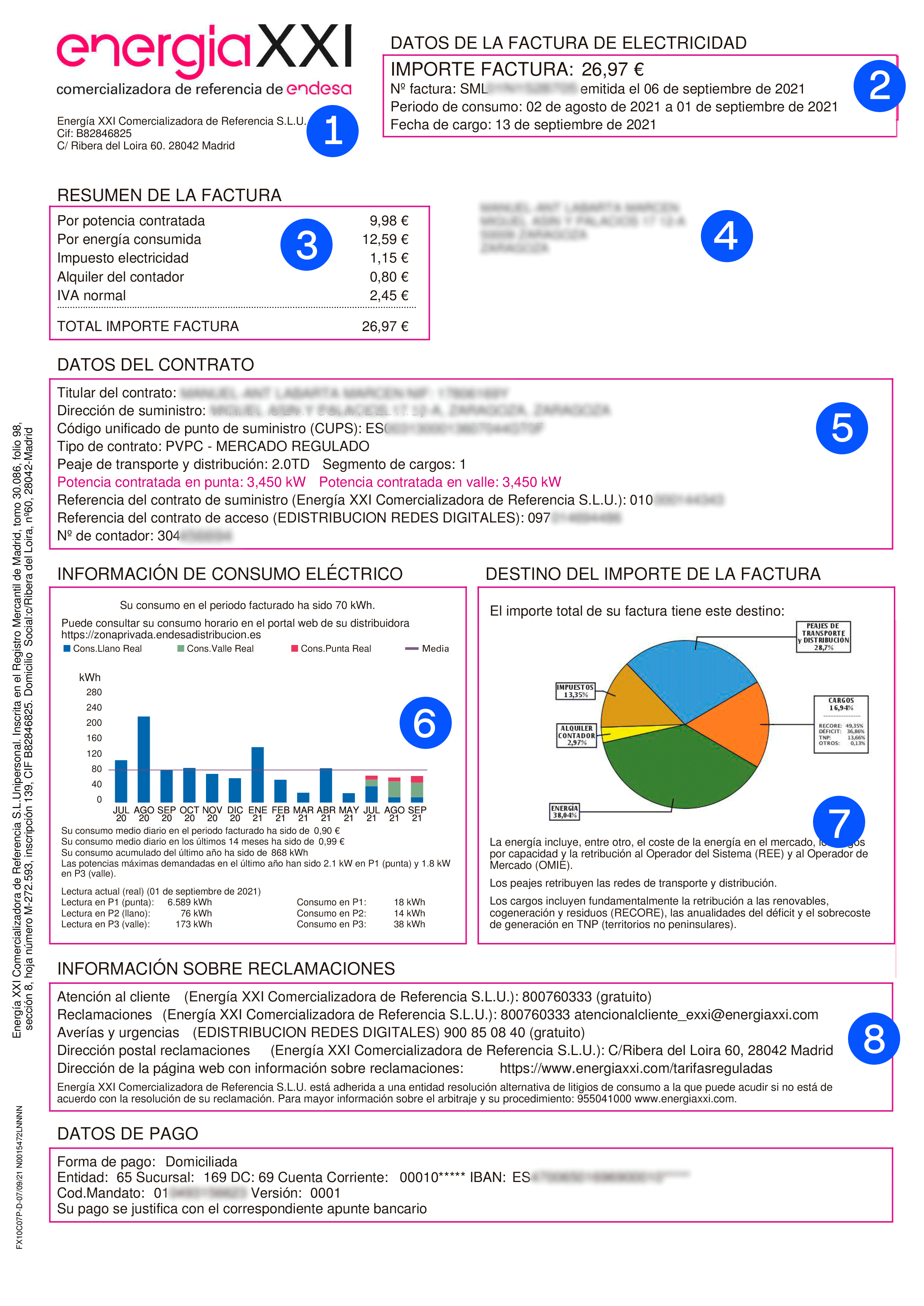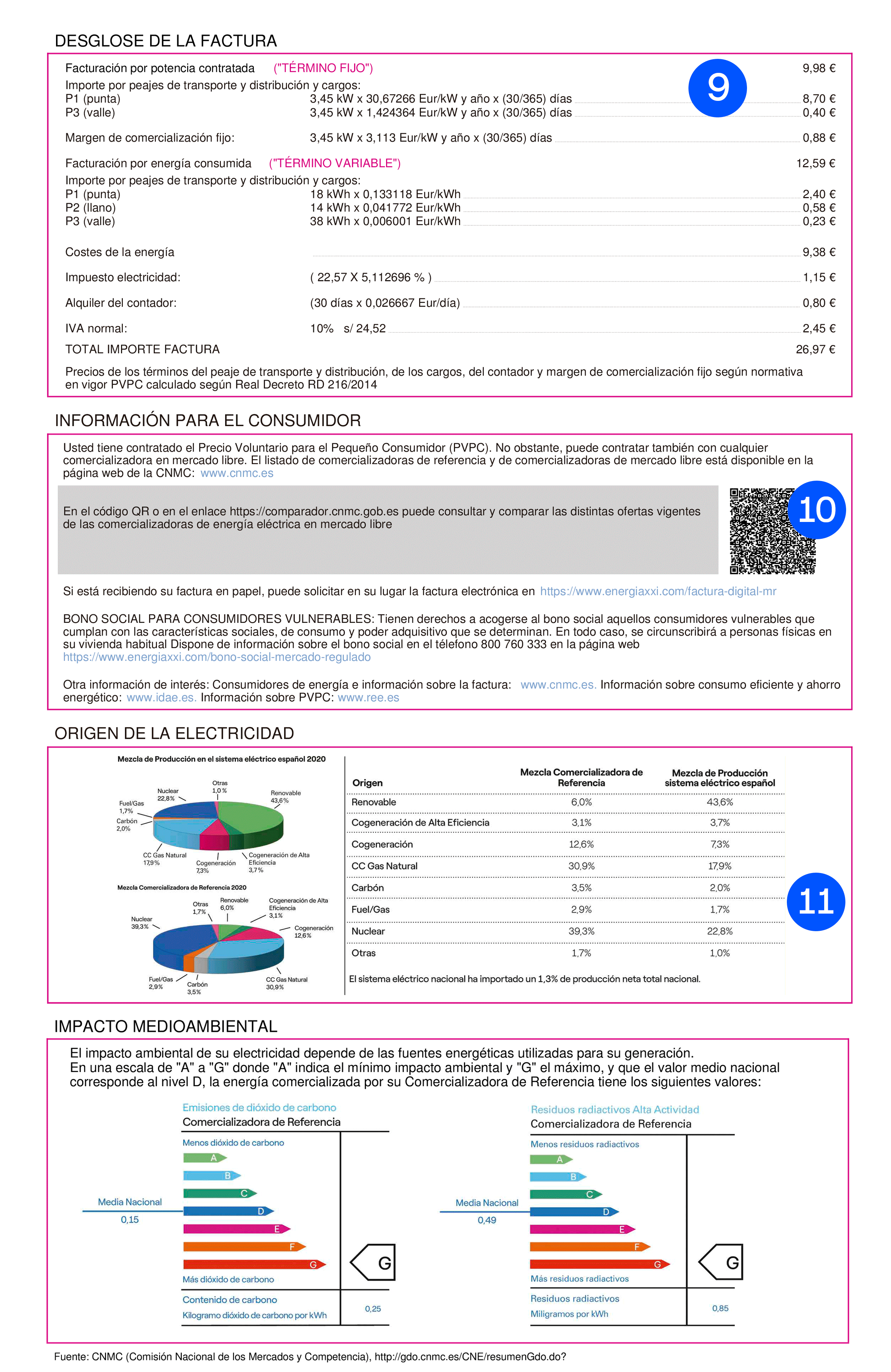Factura de luz de Energía XXI
Te explicamos todos los aspectos de tu factura de la luz para que conozcas sus diferentes apartados y costes.
Cambios en 2021 de tu factura de Energía XXI
Si ya estás familiarizado con la factura de Energía XXI te explicamos brevemente que cambios se han producido a partir de junio de 2021.
Además de algunas modificaciones estéticas y de forma, la información es fundamentalmente la misma, pero más detallada.
Con tu próxima factura te llegara una circular sobre los nuevos peajes en las facturas de la luz del mercado regulado. En el desglose de tu factura (punto 9) puedes encontrar como se aplican ahora esos costes regulados tanto al término de potencia como de energía.
Cómo entender tu factura de la luz del mercado regulado
En tu factura de luz del mercado regulado encontraras las siguientes secciones.
1. Identificador de la compañía
Toda la información referente a tu comercializadora de luz del mercado regulado: el logotipo de Energía XXI, la denominación social, el CIF y nuestro domicilio social.
2. Datos de tu factura de la luz de Energía XXI
Aquí, además del importe total a abonar, aparecen los datos de identificación de esta factura. Estos datos son necesarios si quieres hacernos cualquier consulta sobre ella:
- Importe de la factura: El total en euros.
- Número de factura: Número identificativo fiscal.
- Periodo de consumo: Es el intervalo de tiempo al que hace referencia esta factura.
- Fecha de cargo/fecha límite de pago: Si tienes el pago domiciliado, es la fecha en la que se te hará el cargo en tu cuenta. Si no tienes domiciliada la factura de la luz, esta es la fecha límite en la que tienes que realizar el pago.
Si tienes dudas para abonarla puedes consultar toda la información sobre cómo pagar tu factura en Energía XXI.
3. Resumen de la factura PVPC
En este apartado encontrarás un resumen de los diversos costes en los que se divide la factura de la luz del mercado regulado. En el reverso de la factura puedes ver desglosado también cada uno de ellos:
- Por potencia contratada: el coste por la potencia (kW) que tenemos contratada.
- Por energía consumida: el importe que pagas por la cantidad de luz que has consumido durante el periodo de facturación.
- Impuesto electricidad: es un impuesto que tiene la electricidad y cuyo valor está regulado por el Gobierno.
- Alquiler del contador: refleja el coste del alquiler del contador que comunica cuántos kWh consumes cada hora de cada día.
- Impuesto aplicado (xx %): se refleja el impuesto correspondiente (IVA, IGIC o IPSI según el lugar de España en que se encuentre la vivienda o negocio al que se refiere la factura).
- Total importe factura: es la suma de todos los importes anteriores.
4. Nombre y dirección del cliente
Se muestran los datos personales (nombre y dirección) del titular del contrato para el que se emite la factura.
5. Datos del contrato en vigor
En esta sección se muestran los datos de tu contrato con Energía XXI:
Titular, NIF y dirección de suministro: los datos del titular del contrato, así como la dirección del punto de suministro. Si algún dato no fuese correcto puedes ponerte en contacto con Atención al cliente de Energía XXI.
Código unificado de punto de suministro o CUPS: el código único que identifica tu punto de suministro. Todas las viviendas y negocios tienen un CUPS que les identifica y que nunca cambia (aunque lo hagan sus propietarios y/o inquilinos).
Tipo de contrato: el modelo de contrato. En la mayoría de los casos es PVPC (Precio Voluntario para el Pequeño Consumidor) del Mercado Regulado.
Si tienes asignado el Bono Social se mostrara PVPC con Bono Social y el % de descuento. Al final de este artículo encontrarás todo lo que cambia en tu factura de la luz de Energía XXI si tienes concedido el Bono Social.
Peaje de transporte y distribución: los costes regulados por el acceso a la red eléctrica. Bajo la denominación 2.0 TD se indica el tipo de peaje que se le aplica a tu factura de la luz. Esta cantidad se destina a pagar lo que cuesta hacer llegar la electricidad hasta tu casa.
Segmento de cargos: el segmento en el que se encuentra tu tipo de suministro para otros cargos regulados (diferentes de los peajes). En el caso de potencias <15kW el segmento de cargos que te corresponde es el 1. Estos cargos se destinan, por ejemplo, para costear la producción de energía en territorios no peninsulares, para el tratamiento de residuos, para el déficit que acumula el sistema eléctrico, etc.
Potencia contratada en punta: la potencia máxima (en kW) que tu vivienda/negocio podrá suministrar a tus electrodomésticos en un mismo momento durante las horas punta.
Potencia contratada en valle: la potencia máxima (en kW) que tu vivienda/negocio podrá suministrar a tus electrodomésticos en un mismo momento durante las horas valle. Puede ser la misma que en horas punta, pero eres libre de solicitar su modificación para así tener una potencia más alta en las horas en que te va a salir más barato.
Referencia del contrato de suministro (Energía XXI): el número de referencia del contrato que tienes con nosotros como compañía de luz del mercado regulado.
Referencia del contrato de acceso (nombre empresa distribuidora): la empresa distribuidora es la que transporta la electricidad hasta el punto de suministro (hasta tu casa o negocio). Se dividen por territorios dentro de España y es diferente a la empresa que te comercializa la energía. No puedes elegir tu distribuidora, ya que te corresponde por territorio. Pero siempre puedes elegir (y cambiar) de comercializadora.
Fecha final contrato: indica el periodo de vigencia del contrato actual que tienes con Energía XXI. La renovación de los contratos se hace automáticamente una vez transcurrido 1 año.
Nº de contador: la referencia al número de contador para tu instalación eléctrica.
6. Información de consumo eléctrico
En esta sección puedes consultar el consumo eléctrico realizado en el periodo de facturación medido en kW consumidos por hora (kWh).
También se muestra una gráfica para que conozcas la evolución de tu consumo de luz en los últimos 14 meses facturados en Energía XXI.
Justo debajo de la gráfica encontrarás información interesante si quieres conocer tu patrón de consumo.
- Consumo medio diario en el periodo de esta factura (€).
- Consumo medio diario en los últimos 14 meses (€).
- Consumo acumulado el último año, es decir, todos los kWh consumidos por año.
- Lecturas (real y estimada) en los diferentes periodos de consumo: punta, llano y valle.
7. Destino del importe de tu factura
En forma de un gráfico circular se muestra que porción de la factura de la luz va destina a cada gasto.
- Impuestos.
- Peajes de transporte y distribución: Compañía distribuidora.
- Cargos (Recore, Déficit, TNP, Otros).
- Energía.
- Alquiler de contador.
8. Información sobre reclamaciones
Dentro de la factura de la luz que te envía Energía XXI también hay un apartado en el que revisar las diferentes opciones en caso de necesitar presentar una reclamación.
Por un lado, todos los canales para comunicarte con Energía XXI: número de teléfono de atención y reclamaciones, dirección postal y dirección web.
También encontrarás el número de teléfono correspondiente a la distribuidora que te corresponde según donde se encuentre tu punto de suministro (casa o negocio).
Dado que comercializadora (Energía XXI) y distribuidora son compañías diferentes, tendrás que contactar con una u otra dependiendo del tipo de reclamación que desees hacer.
Debajo de esta información, podrás encontrar los datos bancarios donde se procederá a realizar el cargo por la factura o el talón bancario en el caso de no tengas domiciliada tu factura.
Detalles de la factura de la luz del mercado regulado
Con el objetivo de una mayor transparencia, en el reverso de la factura encontrarás desglosados todos los gastos de la factura de la luz, además de información adicional y de utilidad.
9. Desglose de la factura de Energía XXI
Aquí podemos encontrar de manera detallada cada uno de los importes de los que consta la factura de Energía XXI.
Facturación por potencia contratada en €
También llamado término fijo y se indica, tanto el precio total como cada uno de los costes que lo componen.
- Importe por peajes de transporte y distribución: se aplica tanto en el periodo punta como en el valle y se calcula multiplicando la potencia contratada (kW) por el precio regulado del peaje de esa potencia (€/kW) y por el número de días del año del periodo de la factura.
- Margen de comercialización fijo: es un coste fijo y regulado relacionado con la comercialización de potencia.
Facturación por energía consumida
También conocido como término variable, es la parte de la factura de la luz de Energía XXI que tiene que ver con la cantidad de luz que hemos consumido en el periodo de la factura. Como en el caso anterior, en la factura encontraremos dos importes diferenciados:
- Importe por peajes de transporte y distribución: los costes regulados. Se aplican en tres periodos a lo largo del día (punta, llano y valle). El valor se obtiene multiplicando el valor del peaje (€/kWh) por el consumo que hemos realizado durante ese periodo (kWh).
- Coste de la energía: coste en euros por el consumo de energía que has realizado en el periodo que comprende esta factura, o lo que es lo mismo, el precio por la cantidad de electricidad consumida con Energía XXI.
Impuesto de electricidad
Se trata de un impuesto especial que tienen la electricidad: se calcula añadiendo a tu factura el 5,11269632% del coste de la energía de esa misma factura.
Alquiler del contador
En caso de no contar con un contador en propiedad, en la factura de la luz también vienen reflejado el coste del alquiler del mismo.
Impuesto de aplicación
Son lo que conocemos como impuestos indirectos. El IVA del 21% en Península y Baleares, IGIC en Canarias (0% consumo viviendas con potencia menor o igual a 10kW, resto 3%) e IPSI en Ceuta y Melilla (1%).
Total importe factura
La suma de todos los apartados da como resultado el importe total de la factura de la luz que te envía Energía XXI.
10. Información para el consumidor
Información sobre el tipo de contrato y sobre los diferentes descuentos o recargos. Por ejemplo, la aplicación del Bono Social o por el contrario, recargos por no tener derecho al PVPC.
Adicionalmente, en este apartado de tu factura de Energía XXI también encontrarás un enlace y un código QR que te deriva al comparador de ofertas de energía de la CNMC.
11. Origen e impacto ambiental de la electricidad consumida
En este apartado encontrarás como se etiqueta el tipo de electricidad que consumes, así como su origen y el impacto sobre el medio ambiente.
“Las facturas de la luz con Energía XXI cada día más completas y detalladas”
Continuamos con nuestro compromiso con la transparencia para que puedas conocer todos los detalles de tu factura de la luz de Energía XXI.
Si, además, quieres consultar tu factura desde cualquier lugar, súmate a la factura digital o infórmate sobre la app de Energía XXI.
Factura de la luz del mercado regulado con Bono Social
En el caso de que tengas asignado el Bono Social, dentro de tu factura de la luz de Energía XXI vendrá indicado que eres beneficiario y el porcentaje de descuento al que tienes derecho.
Resumen de la factura con bono social en el mercado regulado
Los datos de esta sección son iguales que en el caso de la factura estándar del PVPC, pero con la diferencia de que se incluye el descuento por bono social.
Datos del contrato con bono social en Energía XXI
De igual modo, en los datos del contrato y en el apartado de tipo de contrato, verás reflejado PVPC con Bono Social y el % de descuento aplicado.
Desglose de la factura para beneficiarios del bono social
En el reverso de la factura, donde se encuentran todos los gastos desglosados, verás reflejado el calculo del descuento por bono social aplicado en el periodo de facturación.
Información de consumo eléctrico con bono social
Si eres cliente con bono social en la sección de información de consumo eléctrico de tu factura de Energía XXI también veras reflejado los consumos bonificados y sin bonificar.
Factura de la luz del mercado regulado para el autoconsumo
Algunos clientes también disponen de placas solares destinadas al autoconsumo y cuyos excedentes de energía se introducen en la red eléctrica general. En este caso reciben una compensación por ese excedente de energía que queda reflejado en su factura de la luz del mercado regulado.
La compensación por excedentes (€ a devolver) aparece, tanto en el resumen de la factura como en el desglose de la misma del reverso.
Además, en el apartado de información del consumo eléctrico se indica la energía excedentaria compensada.
Facturas PVPC de Energía XXI con recargo
Se trata de un caso muy particular pero que conviene aclarar. Si no cumples los requisitos para tener derecho al PVPC, pero por el momento no tienes un contrato en el libre mercado, se te aplicara un recargo en tu factura de la luz de Energía XXI.
Este recargo del 20% viene reflejado, tanto en el resumen de la factura como en el desglose que encontrarás en el revés de la misma.
También, en todo momento, se aclarará que el tipo de contrato que se te está aplicando es el del Precio Voluntario para el Pequeño Consumidor (PVPC) con un recargo del 20%.
Facturación por excesos de potencia en Energía XXI
La mayoría de los hogares y negocios adscritos al mercado regulado no pueden utilizar más potencia de la que tienen contratada. En el caso de que, en un momento puntual, tengas más aparatos eléctricos de los que la potencia máxima contratada te permite, saltará el ICP (lo que antiguamente se llamaba "saltar los plomos") y te quedarás sin luz hasta que vuelvas a subirlo.
Sin embargo, hay quien en lugar de ICP tiene un maxímetro (en los consumidores domésticos es una situación poco habitual). En este caso podrías superar la potencia máxima contratada, en un determinado momento, sin que te salte el diferencial pero asumiendo un coste adicional.
En esta situación verás reflejado ese coste por exceso de potencia, tanto en el resumen de tu factura de la luz de Energía XXI como en el desglose de tu factura bajo el epígrafe facturación por excesos de potencia.


